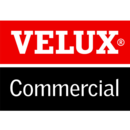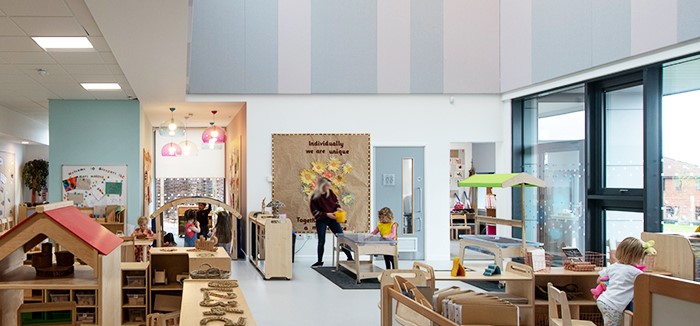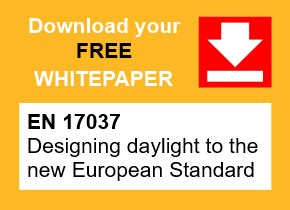Types of building EN 17037 applies to
Contents |
[edit] Introduction
EN 17037 Daylight in buildings was published at the end of 2018 and is the first unified standard, applicable Europe-wide, that deals exclusively with the design for and provision of daylight within commercial buildings and residential dwellings.
EN 17037 can be applied to any building types from commercial buildings such as factories and hospitals to residential dwellings including houses and apartments. The areas of design covered by EN 17037 and the flexibility to decide what performance level is achieved, as long as it meets the minimum recommendation, means internal spaces can be designed to suit intended activities.
The standard is not confined to new buildings. For the renovation and/or conversion of an existing building, EN 17037 provides the methods to assess existing openings against the proposed use and inform any changes to the building fabric accordingly to meet the new European standard.
[edit] Does EN 17037 refer to specific building types?
Section 5.3 of EN 17037 defines assessment of exposure to sunlight and is the only section of the European standard to offer building-specific guidance. It states that at least one habitable space in hospital patient rooms, dwellings and nursery playrooms should provide the minimum performance level for sunlight exposure.
Whilst access to sunlight is desirable, over-exposure can be detrimental to health and wellbeing through excessive solar gains creating an uncomfortable increased internal temperature. This unique building-specific guidance within the standard is recognition that in certain situations building users need a ‘calmer’ space.
[edit] Are any specific levels of illuminance required by EN 17037?
EN 17037 does not specify illuminance levels for individual tasks or uses of a building. The standard instead offers levels of illuminance in terms of the minimum, medium and high-performance levels.
The minimum 300-lux level is based on several studies and has been described as the suitable minimum illumination requirement for prolonged office work and at which the likelihood of switching on electric lighting is low. It is important to note that design levels for artificial lighting also use a 300-lux minimum value.
This gives the specifier or designer the freedom to aim for higher levels where specified by guidance particular to that building type or where certain building uses require it.
Visit the VELUX Commercial website for further guidance on EN 17037.
See also:
VELUX Commercial specialises in designing and manufacturing daylight solutions for commercial and public buildings. Contact us to find out how our products can improve daylight provision in your next project.
[edit] Related articles on Designing Buildings
- Artificial lighting.
- Aspects of daylighting design covered by EN 17037.
- Daylight.
- Daylight factor.
- Daylit space.
- Designing daylight solutions for commercial buildings.
- EN 17037 Daylight in buildings.
- Glare.
- Health and wellbeing impacts of natural and artificial lighting.
- Lighting.
- Lighting and health infographic.
- Lighting designer.
- Lighting and offices.
- Rooflights.
- Site layout planning for daylight and sunlight.
- Solar gain.
- Types of lighting.
- Windows.
Featured articles and news
One of the most impressive Victorian architects. Book review.
RTPI leader to become new CIOB Chief Executive Officer
Dr Victoria Hills MRTPI, FICE to take over after Caroline Gumble’s departure.
Social and affordable housing, a long term plan for delivery
The “Delivering a Decade of Renewal for Social and Affordable Housing” strategy sets out future path.
A change to adoptive architecture
Effects of global weather warming on architectural detailing, material choice and human interaction.
The proposed publicly owned and backed subsidiary of Homes England, to facilitate new homes.
How big is the problem and what can we do to mitigate the effects?
Overheating guidance and tools for building designers
A number of cool guides to help with the heat.
The UK's Modern Industrial Strategy: A 10 year plan
Previous consultation criticism, current key elements and general support with some persisting reservations.
Building Safety Regulator reforms
New roles, new staff and a new fast track service pave the way for a single construction regulator.
Architectural Technologist CPDs and Communications
CIAT CPD… and how you can do it!
Cooling centres and cool spaces
Managing extreme heat in cities by directing the public to places for heat stress relief and water sources.
Winter gardens: A brief history and warm variations
Extending the season with glass in different forms and terms.
Restoring Great Yarmouth's Winter Gardens
Transforming one of the least sustainable constructions imaginable.
Construction Skills Mission Board launch sector drive
Newly formed government and industry collaboration set strategy for recruiting an additional 100,000 construction workers a year.
New Architects Code comes into effect in September 2025
ARB Architects Code of Conduct and Practice available with ongoing consultation regarding guidance.
Welsh Skills Body (Medr) launches ambitious plan
The new skills body brings together funding and regulation of tertiary education and research for the devolved nation.
Paul Gandy FCIOB announced as next CIOB President
Former Tilbury Douglas CEO takes helm.

























